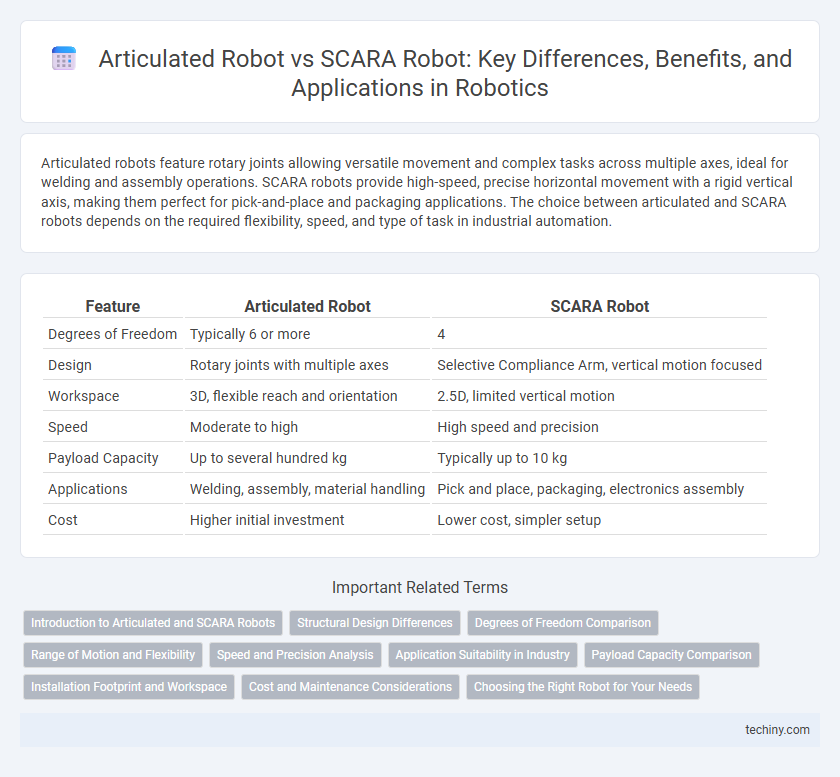Articulated robots feature rotary joints allowing versatile movement and complex tasks across multiple axes, ideal for welding and assembly operations. SCARA robots provide high-speed, precise horizontal movement with a rigid vertical axis, making them perfect for pick-and-place and packaging applications. The choice between articulated and SCARA robots depends on the required flexibility, speed, and type of task in industrial automation.
Table of Comparison
| Feature | Articulated Robot | SCARA Robot |
|---|---|---|
| Degrees of Freedom | Typically 6 or more | 4 |
| Design | Rotary joints with multiple axes | Selective Compliance Arm, vertical motion focused |
| Workspace | 3D, flexible reach and orientation | 2.5D, limited vertical motion |
| Speed | Moderate to high | High speed and precision |
| Payload Capacity | Up to several hundred kg | Typically up to 10 kg |
| Applications | Welding, assembly, material handling | Pick and place, packaging, electronics assembly |
| Cost | Higher initial investment | Lower cost, simpler setup |
Introduction to Articulated and SCARA Robots
Articulated robots feature rotary joints allowing a wide range of motion, ideal for complex tasks requiring flexibility and precision in manufacturing and assembly lines. SCARA robots, known for their selective compliance arm and horizontal movement, excel in high-speed, repeatable operations such as pick-and-place, packaging, and electronics assembly. Both robot types optimize automation efficiency but differ in mechanical structure and application suitability, with articulated robots offering greater versatility and SCARA robots emphasizing speed and accuracy.
Structural Design Differences
Articulated robots feature multiple rotary joints allowing extensive flexibility and a wide range of motion in three-dimensional space, making them ideal for complex tasks requiring high degrees of freedom. SCARA robots, characterized by their rigid arm structures with parallel rotary joints primarily operating in a horizontal plane, excel in high-speed, precise assembly applications with limited vertical movement. The distinct structural design differences influence their workspace, load capacity, and suitability for different industrial automation tasks.
Degrees of Freedom Comparison
Articulated robots typically have 6 degrees of freedom, offering greater flexibility and a wider range of motion for complex tasks. SCARA robots usually possess 4 degrees of freedom, which limits their movement to primarily horizontal and vertical directions suitable for pick-and-place operations. The higher degrees of freedom in articulated robots enable intricate manipulations, while SCARA robots provide speed and precision in simpler, planar tasks.
Range of Motion and Flexibility
Articulated robots feature multiple rotary joints, enabling a wide range of motion and exceptional flexibility suitable for complex tasks requiring 6 or more degrees of freedom. SCARA robots operate primarily with a rigid vertical axis and two parallel rotary joints, offering high-speed, precise horizontal movements but limited vertical flexibility. The extended articulation of articulated robots allows intricate three-dimensional manipulation, whereas SCARA robots excel in fast, repetitive operations within confined planes.
Speed and Precision Analysis
Articulated robots offer superior flexibility with multiple rotary joints, enabling complex movements but generally operate at moderate speeds with high precision suitable for intricate tasks. SCARA robots excel in high-speed operations and deliver exceptional horizontal precision, making them ideal for assembly and pick-and-place applications where rapid repetition and accuracy are crucial. Speed analysis reveals SCARA robots outperform articulated robots in cycle times, while precision assessments highlight articulated robots' advantage in multi-axis accuracy and complex trajectory control.
Application Suitability in Industry
Articulated robots excel in complex assembly and welding tasks due to their multiple degrees of freedom, allowing precise movement in three-dimensional space. SCARA robots are ideal for high-speed, repetitive operations such as pick-and-place, packaging, and assembly on flat surfaces, offering superior rigidity and accuracy. Industries choosing between these robots focus on application requirements like flexibility, speed, and load capacity to optimize production efficiency.
Payload Capacity Comparison
Articulated robots typically offer higher payload capacities, often exceeding 20 kg, due to their multiple rotary joints that provide enhanced flexibility and strength. SCARA robots generally have payload capacities ranging from 1 kg to 10 kg, optimized for fast, precise horizontal movements in assembly applications. Payload capacity differences influence the selection process, where articulated robots are preferred for heavy-duty tasks, and SCARA robots suit lighter, high-speed operations.
Installation Footprint and Workspace
Articulated robots typically require a larger installation footprint due to their multi-jointed arms and complex range of motion, making them suitable for tasks needing extensive reach and flexibility. SCARA robots occupy a smaller footprint with a compact, horizontal design, providing an efficient workspace ideal for high-speed, precise assembly applications. The choice between articulated and SCARA robots depends on balancing available floor space and the specific workspace requirements of the application.
Cost and Maintenance Considerations
Articulated robots generally have a higher initial cost due to their complex joint structures and advanced capabilities, whereas SCARA robots are more cost-effective for tasks requiring high-speed and precision in a limited workspace. Maintenance for articulated robots can be more intensive and costly because of their multiple degrees of freedom and intricate mechanical parts, while SCARA robots benefit from simpler designs that typically reduce downtime and service expenses. Choosing between them depends on budget constraints, application complexity, and long-term operational costs in industrial automation.
Choosing the Right Robot for Your Needs
Articulated robots offer a wide range of motion with multiple rotary joints, ideal for complex tasks requiring flexibility and precision in industries such as automotive and aerospace. SCARA robots excel in high-speed, repetitive pick-and-place operations with excellent horizontal rigidity and vertical compliance, making them suitable for electronics assembly and packaging. Selecting the right robot depends on factors like workspace layout, payload capacity, speed, precision requirements, and task complexity to optimize productivity and cost-efficiency.
Articulated robot vs SCARA robot Infographic

 techiny.com
techiny.com